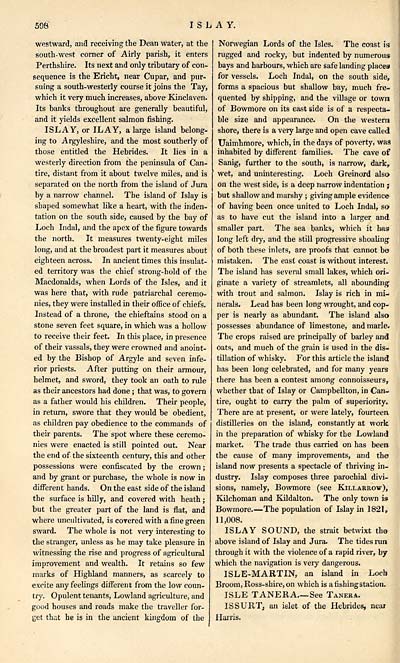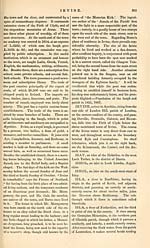Gazetteer of Scotland > Volume 2
(114) Page 598
Download files
Complete book:
Individual page:
Thumbnail gallery: Grid view | List view

598
I S L A Y.
westward, and receiving the Dean water, at the
south-west corner of Airly parish, it enters
Perthshire. Its next and only tributary of con-
sequence is the Ericht, near Cupar, and pur-
suing a south-westerly course it joins the Tay,
which it very much increases, above Kinclaven.
Its banks throughout are generally beautiful,
and it yields excellent salmon fishing.
ISLAY, or ILAY, a large island belong-
ing to Argyleshire, and the most southerly of
those entitled the Hebrides. It lies in a
westerly direction from the peninsula of Can-
tire, distant from it about twelve miles, and is
separated on the north from the island of Jura
by a narrow channel. The island of Islay is
shaped somewhat like a heart, with the inden-
tation on the south side, caused by the bay of
Loch Indal, and the apex of the figure towards
the north. It measures twenty-eight miles
long, and at the broadest part it measures about
eighteen across. In ancient times this insulat-
ed territory was the chief strong-hold of the
Macdonalds, when Lords of the Isles, and it
was here that, with rude patriarchal ceremo-
nies, they were installed in their office of chiefs.
Instead of a throne, the chieftains stood on a
stone seven feet square, in which was a hollow
to receive their feet. In this place, in presence
of their vassals, they were crowned and anoint-
ed by the Bishop of Argyle and seven infe-
rior priests. After putting on their armour,
helmet, and sword, they took an oath to rule
as their ancestors had done ; that was, to govern
as a father would his children. Their people,
in return, swore that they would be obedient,
as children pay obedience to the commands of
their parents. The spot where these ceremo-
nies were enacted is still pointed out. Near
the end of the sixteenth century, this and other
possessions were confiscated by the crown;
and by grant or purchase, the whole is now in
different hands. On the east side of the island
the surface is hilly, and covered with heath ;
but the greater part of the land is flat, and
where uncultivated, is covered with a fine green
sward. The whole is not very interesting to
the stranger, unless as he may take pleasure in
witnessing the rise and progress of agricultural
improvement and wealth. It retains so few
marks of Highland manners, as scarcely to
excite any feelings different from the low coun-
try. Opulent tenants, Lowland agriculture, and
good houses and roads make the traveller for-
get that he is in the ancient kingdom of the
Norwegian Lords of the Isles. The coast is
rugged and rocky, but indented by numerous
bays and harbours, which are safe landing places
for vessels. Loch Indal, on the south side,
forms a spacious but shallow bay, much fre-
quented by shipping, and the village or town
of Bowmore on its east side is of a respecta-
ble size and appearance. On the western
shore, there is a very large and open cave called
Uaimhmore, which, in the days of poverty, was
inhabited by different families. The cave of
Sanig, further to the south, is narrow, dark,
wet, and uninteresting. Loch Greinord also
on the west side, is a deep narrow indentation ;
but shallow and marshy ; giving ample evidence
of having been once united to Loch Indal, so
as to have cut the island into a larger and
smaller part. The sea banks, which it has
long left dry, and the still progressive shoaling
of both these inlets, are proofs that cannot be
mistaken. The east coast is without interest.
The island has several small lakes, which ori-
ginate a variety of streamlets, all abounding
with trout and salmon. Islay is rich in mi-
nerals. Lead has been long wrought, and cop-
per is nearly as abundant. The island also
possesses abundance of limestone, and marie.
The crops raised are principally of barley and
oats, and much of the grain is Used in the dis-
tillation of whisky. For this article the island
has been long celebrated, and for many years
there has been a contest among connoisseurs,
whether that of Islay or Campbellton, in Can-
tire, ought to carry the palm of superiority.
There are at present, or were lately, fourteen
distilleries on the island, constantly at work
in the preparation of whisky for the Lowland
market. The trade thus carried on has been
the cause of many improvements, and the
island now presents a spectacle of thriving in-
dustry. Islay composes three parochial divi-
sions, namely, Bowmore (see Killarrow),
Kilchoman and Kildalton. The only town is
Bowmore. — The population of Islay in 1821,
11,008.
ISLAY SOUND, the strait betwixt the
above island of Islay and Jura. The tides run
through it with the violence of a rapid river, by
which the navigation is very dangerous.
ISLE-MARTIN, an island in Loch
Broom, Ross-shire, on which is a fishing station.
ISLE TANERA See Tanera.
ISSURTj an islet of the Hebrides, near
Harris.
I S L A Y.
westward, and receiving the Dean water, at the
south-west corner of Airly parish, it enters
Perthshire. Its next and only tributary of con-
sequence is the Ericht, near Cupar, and pur-
suing a south-westerly course it joins the Tay,
which it very much increases, above Kinclaven.
Its banks throughout are generally beautiful,
and it yields excellent salmon fishing.
ISLAY, or ILAY, a large island belong-
ing to Argyleshire, and the most southerly of
those entitled the Hebrides. It lies in a
westerly direction from the peninsula of Can-
tire, distant from it about twelve miles, and is
separated on the north from the island of Jura
by a narrow channel. The island of Islay is
shaped somewhat like a heart, with the inden-
tation on the south side, caused by the bay of
Loch Indal, and the apex of the figure towards
the north. It measures twenty-eight miles
long, and at the broadest part it measures about
eighteen across. In ancient times this insulat-
ed territory was the chief strong-hold of the
Macdonalds, when Lords of the Isles, and it
was here that, with rude patriarchal ceremo-
nies, they were installed in their office of chiefs.
Instead of a throne, the chieftains stood on a
stone seven feet square, in which was a hollow
to receive their feet. In this place, in presence
of their vassals, they were crowned and anoint-
ed by the Bishop of Argyle and seven infe-
rior priests. After putting on their armour,
helmet, and sword, they took an oath to rule
as their ancestors had done ; that was, to govern
as a father would his children. Their people,
in return, swore that they would be obedient,
as children pay obedience to the commands of
their parents. The spot where these ceremo-
nies were enacted is still pointed out. Near
the end of the sixteenth century, this and other
possessions were confiscated by the crown;
and by grant or purchase, the whole is now in
different hands. On the east side of the island
the surface is hilly, and covered with heath ;
but the greater part of the land is flat, and
where uncultivated, is covered with a fine green
sward. The whole is not very interesting to
the stranger, unless as he may take pleasure in
witnessing the rise and progress of agricultural
improvement and wealth. It retains so few
marks of Highland manners, as scarcely to
excite any feelings different from the low coun-
try. Opulent tenants, Lowland agriculture, and
good houses and roads make the traveller for-
get that he is in the ancient kingdom of the
Norwegian Lords of the Isles. The coast is
rugged and rocky, but indented by numerous
bays and harbours, which are safe landing places
for vessels. Loch Indal, on the south side,
forms a spacious but shallow bay, much fre-
quented by shipping, and the village or town
of Bowmore on its east side is of a respecta-
ble size and appearance. On the western
shore, there is a very large and open cave called
Uaimhmore, which, in the days of poverty, was
inhabited by different families. The cave of
Sanig, further to the south, is narrow, dark,
wet, and uninteresting. Loch Greinord also
on the west side, is a deep narrow indentation ;
but shallow and marshy ; giving ample evidence
of having been once united to Loch Indal, so
as to have cut the island into a larger and
smaller part. The sea banks, which it has
long left dry, and the still progressive shoaling
of both these inlets, are proofs that cannot be
mistaken. The east coast is without interest.
The island has several small lakes, which ori-
ginate a variety of streamlets, all abounding
with trout and salmon. Islay is rich in mi-
nerals. Lead has been long wrought, and cop-
per is nearly as abundant. The island also
possesses abundance of limestone, and marie.
The crops raised are principally of barley and
oats, and much of the grain is Used in the dis-
tillation of whisky. For this article the island
has been long celebrated, and for many years
there has been a contest among connoisseurs,
whether that of Islay or Campbellton, in Can-
tire, ought to carry the palm of superiority.
There are at present, or were lately, fourteen
distilleries on the island, constantly at work
in the preparation of whisky for the Lowland
market. The trade thus carried on has been
the cause of many improvements, and the
island now presents a spectacle of thriving in-
dustry. Islay composes three parochial divi-
sions, namely, Bowmore (see Killarrow),
Kilchoman and Kildalton. The only town is
Bowmore. — The population of Islay in 1821,
11,008.
ISLAY SOUND, the strait betwixt the
above island of Islay and Jura. The tides run
through it with the violence of a rapid river, by
which the navigation is very dangerous.
ISLE-MARTIN, an island in Loch
Broom, Ross-shire, on which is a fishing station.
ISLE TANERA See Tanera.
ISSURTj an islet of the Hebrides, near
Harris.
Set display mode to: Large image | Transcription
Images and transcriptions on this page, including medium image downloads, may be used under the Creative Commons Attribution 4.0 International Licence unless otherwise stated. ![]()
| Gazetteers of Scotland, 1803-1901 > Gazetteer of Scotland > Volume 2 > (114) Page 598 |
|---|
| Permanent URL | https://digital.nls.uk/97432190 |
|---|
| Description | Volume II: Glenbanchor to Zetland. |
|---|---|
| Attribution and copyright: |
|
| Description | By Robert Chambers and William Chambers. Glasgow: Blackie & Son, 1838. 2 volumes. |
|---|---|
| Shelfmark | NF.1461.g.7 |
| Additional NLS resources: | |

